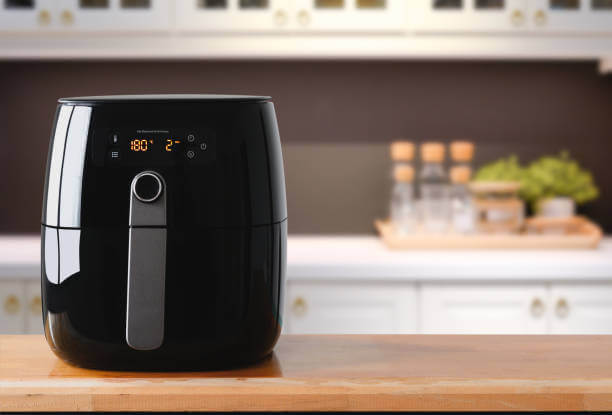Hello Everyone, In the realm of modern kitchen appliances, the air fryer stands as a true game-changer, revolutionizing the way we cook and enjoy our favorite dishes. But have you ever wondered, amidst the captivating aroma and the crispy results, what’s the science behind the air fryer’s enchantment? The secret lies in its innovative approach to cooking that combines the power of rapid hot air circulation with a hint of culinary ingenuity.
Unlike traditional frying methods that rely heavily on oil immersion, air fryers use convection technology to evenly distribute high-temperature air around the food. This dynamic process creates a crispy exterior that rivals deep frying, all while using significantly less oil, making it a healthier alternative that still satisfies our cravings for that delectable crunch.
In this exploration, we’ll delve into the inner workings of air fryers, understand the magic they wield, and uncover the myriad advantages they bring to our culinary endeavors. So, let’s embark on a journey to demystify the mechanics of air fryers and discover the art of modern, guilt-free frying.
What is an air fryer?

An air fryer is a popular kitchen appliance that has gained tremendous attention for its ability to replicate the taste and texture of deep-fried foods using significantly less oil. It operates on a powerful convection cooking technology, harnessing the magic of hot air circulation to create crispy exteriors while maintaining the juiciness and tenderness of the food within. This innovative cooking method has made it a go-to choice for health-conscious individuals who want to enjoy fried flavors without the excess oil and calories.
Inside an air fryer, there’s a heating element that produces the necessary high temperatures and a fan that circulates this hot air around the food. This even distribution of heat ensures that the entire surface of the food is exposed to hot air, resulting in a uniform and consistent cooking. Unlike traditional frying, which requires food to be submerged in oil, air fryers typically need only a tiny amount of oil, often just a light spritz or brushing, to achieve that crispy texture.
Air fryers aren’t limited to frying alone; they can handle various cooking tasks. From roasting vegetables and baking chicken to grilling fish and even making crispy snacks like potato chips, they’re versatile appliances that can help you create a variety of dishes. Additionally, many air fryers come with adjustable temperature and timing settings, allowing you to fine-tune your cooking process for different recipes. This level of control, combined with the healthier cooking method, makes air fryers a favorite among those seeking a balance between taste and nutrition.
Best AirFryer To Buy:- GoWise AirFryer Review
How does an air fryer work?
An air fryer operates by utilizing a powerful convection heating system combined with rapid hot air circulation to cook food. The fundamental principle behind an air fryer is to replicate the crispy texture and delicious taste of deep-frying while significantly reducing the amount of oil required. This innovative cooking process makes it a popular choice for those who want to enjoy indulgent flavors without the guilt of excessive oil consumption.
Inside the air fryer, there’s a heating element, usually located at the top, that generates intense heat. The hot air is then rapidly circulated around the food by a high-speed fan. This continuous circulation of hot air creates a crispy outer layer by removing excess moisture from the food’s surface, resulting in the desirable crunchy texture that people love in fried foods. Additionally, the even distribution of heat ensures that the food cooks uniformly, eliminating the need for constant flipping or turning, as is often necessary in traditional frying.
The cooking temperature in an air fryer is adjustable, allowing you to set the desired level of heat for different recipes. Many air fryers also come with a timer, which ensures precise cooking times. Some models feature specialized cooking presets for popular dishes, simplifying the cooking process further. It’s essential to preheat the air fryer before placing the food inside, as this helps achieve optimal results. This combination of precise temperature control, rapid air circulation, and minimal oil usage results in food that’s not only crispy and delicious but also healthier than traditional frying methods.
Benefits of using an air fryer
Air fryers have gained immense popularity due to their ability to prepare delicious and crispy food with less oil, making them a healthier alternative to traditional frying methods. Here are the key benefits of using an air fryer:
- Healthier Cooking: Air fryers require significantly less oil compared to deep frying. The hot air circulation cooks the food evenly and creates a crispy outer layer, providing the satisfying texture of fried food without excessive oil and calories. This makes it a great option for those aiming to reduce their oil intake.
- Reduced Fat Content: By using less oil, air frying can significantly reduce the fat content in your meals. This is especially advantageous for individuals watching their fat consumption for health reasons, such as those with heart conditions or weight management goals.
- Versatility: Air fryers are incredibly versatile appliances. They can handle a wide range of cooking tasks, from frying and grilling to baking and roasting. You can prepare a variety of foods, including meats, vegetables, frozen snacks, and even baked goods, all in one convenient appliance.
- Faster Cooking: Air fryers typically cook food faster than conventional ovens. The rapid hot air circulation results in shorter cooking times, helping you get meals on the table quickly, making it perfect for busy individuals and families.
- Energy Efficiency: Air fryers use less energy compared to traditional ovens. Their compact size and efficient heating elements mean you can save on electricity while still enjoying well-cooked meals.
- Less Mess: Air fryers usually have non-stick cooking surfaces, making cleanup much easier. Plus, there’s no messy oil to deal with, reducing the hassle and time spent on cleaning up after cooking.
- Preserves Nutrients: The quick cooking process of air frying helps preserve the nutritional content of food. This is particularly important for foods with sensitive nutrients that can be lost with prolonged cooking.
- Safe and User-Friendly: Air fryers are generally easy to use with simple controls, making them suitable for cooks of all levels, including beginners and busy professionals. They also come with safety features, such as auto shut-off, to prevent overcooking or accidents.
In summary, the benefits of using an air fryer encompass healthier cooking, reduced fat consumption, versatility, faster cooking times, energy efficiency, easier cleanup, nutrient preservation, and user-friendly operation. Incorporating an air fryer into your kitchen can enhance your cooking experience while promoting a healthier lifestyle.
How to choose the right air fryer?
Choosing the right air fryer for your needs requires considering several important factors to ensure that you get an appliance that matches your cooking preferences, kitchen space, and budget. Here’s a comprehensive guide on how to choose the right air fryer:
1. Cooking Capacity: Determine the amount of food you typically cook. If you often cook for a large family or like to prepare multiple servings at once, a larger-capacity air fryer is ideal. For smaller households or limited counter space, a compact air fryer with a smaller capacity might be sufficient.
2. Cooking Functions: Look for air fryers with versatile cooking functions. Many modern air fryers not only air fry but also offer additional cooking methods like grilling, roasting, baking, and even dehydrating. Having multiple cooking options in one appliance can be highly convenient.
3. Temperature and Timer Controls: Ensure the air fryer allows you to set specific cooking temperatures and timers. Adjustable temperature settings give you more precise control over the cooking process, allowing you to achieve the desired level of crispiness. Timers are essential for preventing overcooking and ensuring your food turns out perfectly every time.
4. Power and Performance: Consider the wattage of the air fryer. Higher wattage typically means faster cooking and more efficient heat circulation. However, keep in mind that higher wattage may also mean more energy consumption.
5. Reviews and Ratings: Check customer reviews and ratings for different air fryer models. Real-world experiences can give you insights into the performance, durability, and ease of use of the appliance. Look for models with consistently positive reviews and ratings.
6. Additional Features: Some air fryers come with extra features, such as pre-set cooking modes for specific dishes, digital touchscreens, and removable, dishwasher-safe parts for easy cleaning. These features can enhance the overall user experience.
7. Budget: Set a budget that fits your needs. Air fryers come in a wide price range, and while more expensive models may have advanced features, there are also budget-friendly options that deliver excellent results.
8. Brand Reputation: Consider reputable and well-established brands known for producing high-quality kitchen appliances. Trusted brands often offer better warranties and customer support.
9. Counter Space: Measure your kitchen counter space to ensure the air fryer will fit comfortably. Some models have a sleek, compact design, making them suitable for smaller kitchens.
10. Warranty: Check the manufacturer’s warranty. A longer warranty period indicates that the manufacturer is confident in the durability and performance of the air fryer.
By carefully evaluating these factors, you can find the air fryer that best suits your cooking needs, fits your kitchen, and delivers delicious results every time you use it.
How to clean an air fryer?
Cleaning an air fryer is essential to maintain its performance, extend its lifespan, and ensure that the food you prepare remains safe and delicious. Here’s a comprehensive guide on how to clean an air fryer effectively:
1. Unplug and Cool Down: Safety is paramount. Before cleaning, make sure the air fryer is unplugged and has cooled down sufficiently to avoid burns.
2. Remove Removable Parts: Most air fryers have removable parts, such as the cooking basket and tray. Take out these components carefully.
3. Wash Removable Parts: Wash the cooking basket, tray, and any other removable parts with warm, soapy water. You can also use a non-abrasive sponge or brush to remove any food residue. Some models have dishwasher-safe parts, so check the user manual for guidance.
4. Clean the Interior: Wipe the interior of the air fryer with a damp cloth or sponge to remove any grease or food particles. Be gentle, as the heating elements can be delicate.
5. Check the Heating Element: If there’s any food debris on the heating element, carefully remove it using a soft brush or cloth.
6. Clean the Exterior: Wipe down the exterior of the air fryer with a damp cloth to remove any grease or spills. Be sure to dry it thoroughly to prevent any water from entering the appliance.
7. Clean the Heating Element Guard: Some air fryer models have a heating element guard or cover. If your model has this component, clean it as per the manufacturer’s instructions.
8. Handle Odors: If there are any lingering odors from previous cooking, you can place a small bowl of vinegar or a mixture of water and lemon juice inside the air fryer and run it at a low temperature for a few minutes to help eliminate odors.
9. Avoid Abrasive Cleaners: Never use abrasive cleaners, steel wool, or harsh chemicals on the air fryer.
10. Regular Maintenance: Clean your air fryer after each use to prevent the buildup of grease and food residue. Regular maintenance ensures that your air fryer continues to work efficiently and produces delicious meals.
11. Deep Cleaning: For a thorough deep clean, you can soak the removable parts in warm, soapy water for a few hours before gently scrubbing them clean.
By following these cleaning tips, you can keep your air fryer in top-notch condition, ready to prepare tasty and healthy meals with ease. Regular maintenance ensures that your air fryer remains a reliable kitchen appliance for years to come.
What are some air fryer recipes?
Air fryers have become a beloved kitchen tool for those seeking healthier cooking options that still deliver delicious, crispy results. Here are some popular air fryer recipes that showcase the versatility and convenience of this appliance:
1. Air Fryer French Fries: Crispy, golden-brown fries can be achieved with minimal oil in an air fryer. Simply cut potatoes into desired shapes, lightly toss them in a bit of oil, season with salt and your favorite spices, and air fry until crispy and delicious.
2. Air Fryer Chicken Wings: Chicken wings cooked in an air fryer are a game-day favorite. Coat the wings with a marinade or dry rub, then air fry until they’re crispy on the outside and tender on the inside. Toss them in your favorite sauce for an extra kick of flavor.
3. Air Fryer Vegetables: From Brussels sprouts to zucchini, air fryers are excellent for roasting vegetables. Toss them in a bit of oil, season with herbs and spices, and air fry until they’re caramelized and flavorful.
4. Air Fryer Salmon: Cooking salmon in an air fryer results in crispy skin and tender, flaky flesh. Brush the salmon with a marinade or simply season with salt and pepper, then air fry until cooked to your desired doneness.
5. Air Fryer Chicken Tenders: Perfect for a quick and easy meal, air fryer chicken tenders are crispy and delicious. Dip the tenders in beaten egg, coat with breadcrumbs, and air fry until golden and cooked through.
6. Air Fryer Desserts: Yes, you can even make desserts in an air fryer! Try making mini apple pies, churros, or even donuts using prepared dough or batter. They come out with a lovely crisp texture.
7. Air Fryer Grilled Cheese: Elevate your grilled cheese sandwich by air frying it. The result is a perfectly toasted, crispy sandwich with melted cheese.
8. Air Fryer Egg Rolls: Make restaurant-style egg rolls at home with your air fryer. Fill egg roll wrappers with your choice of ingredients, brush with a bit of oil, and air fry until they’re crispy and irresistible.
9. Air Fryer Meatballs: Whether you’re using ground beef, turkey, or a plant-based alternative, air fryer meatballs come out beautifully browned and flavorful.
10. Air Fryer Roast Chicken: You can even roast a whole chicken in an air fryer! Season the chicken, place it in the air fryer basket, and roast until the skin is crispy and the meat is cooked through.
These are just a few examples of the many delicious dishes you can prepare in an air fryer. Its quick cooking time and ability to achieve a crispy texture with minimal oil make it a versatile and valuable addition to any kitchen.
Must Read:-
- What Can You Cook in a Toaster Oven?
- Toaster vs Air Fryer: Understanding the Key Differences
- Is an Air Fryer a Healthier Option for Cooking?
- How to Find Discounted Toasters in the USA?
Conclusion
In conclusion, the ingenious design of an air fryer utilizes powerful convection technology to circulate hot air rapidly around your food, creating a crispy outer layer while maintaining the juicy goodness within. This efficient process significantly reduces the need for excessive oil, making it a healthier alternative for enjoying the indulgent flavors of fried food.
Whether you’re cooking up crispy fries, tender chicken, or even experimenting with desserts, the air fryer’s ability to provide satisfying results with convenience and speed makes it a remarkable kitchen companion for those seeking delicious, guilt-free meals.

